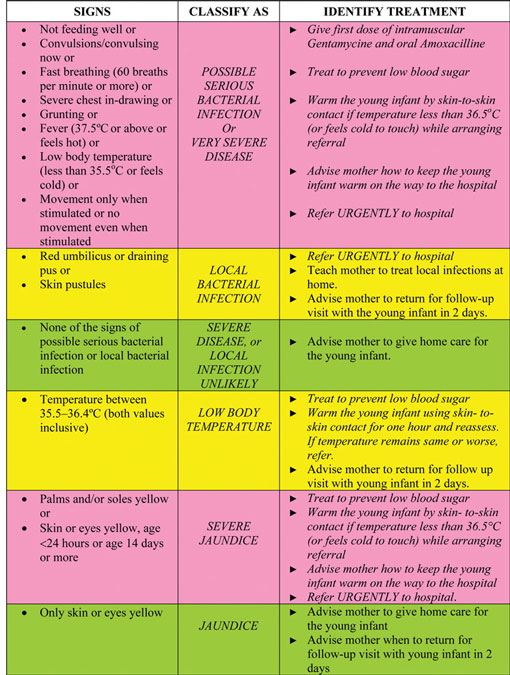3.5 Classify bacterial infection and jaundice
If you have assessed a young infant as having bacterial infection and/or jaundice, you will need to classify the level of seriousness so you know whether to make an urgent referral for relevant medical treatment, or whether you can provide the right treatment yourself.
As you have learned in the study session on immediate newborn care, most classification tables have three rows. Classifications are colour-coded into pink, yellow or green. The colour of the row tells you if the young infant or the child has a serious illness. You can then quickly choose the appropriate treatment.
- A classification in the pink row means that the young infant needs urgent attention and referral or admission for in-patient care. This is a severe classification.
- A classification in the yellow row means that the young infant needs an appropriate antibiotic or other treatment. The treatment includes you teaching the mother how to give the oral drugs or to treat local infections at home and advising her about caring for the young infant at home and when she should return for a follow-up visit.
- A classification in the green row means the young infant is unlikely to have serious bacterial infection and will therefore not need specific medical treatment such as antibiotics. You will need to teach the mother how to care for her young infant at home. For example, you might advise her on feeding her sick young infant or giving fluid for diarrhoea (you will find out more about how to advise and counsel the mother on treating her child at home in Study Session 14 in Part 2 of this Module).
When you are making the postnatal home visit on the third day, you find that the baby has a respiratory rate of 70 breaths per minute and an axillary temperature of 35°C. What other signs should you look for? How would you classify the baby’s illness?
You should ask whether the young infant is feeding poorly, check for severe chest in-drawing, look to see if the baby moves only when stimulated and check for jaundice. Even if the young infant has only two of these signs you would classify the case as possible serious bacterial infection or very severe disease.
In Table 3.1, you can see how bacterial infection and jaundice are classified according to particular signs in the young infant. The most urgent actions that need to be taken are in italics (in the third column).
Table 3.1 Classification and treatment of bacterial infection and jaundice.
3.4 Assess for jaundice

